Submitted:
03 September 2024
Posted:
03 September 2024
You are already at the latest version
Abstract
Keywords:
1. Introduction
2. Materials and Methods
2.1. Wing Model
2.2. Finding and Testing the Design Point
3. Results
3.1. Design Points and Predictive Performance
3.2. SSPOP versus Conventional Optimization
3.2.1. Greedy Search
3.2.2. Other Conventional Optimization Approaches
4. Discussion
4.1. SSPOP and Flight-by-Feel
4.2. SSPOP and Aircraft Design
5. Conclusions
Author Contributions
Funding
Institutional Review Board Statement
Data Availability Statement
Acknowledgments
Conflicts of Interest
References
- Usherwood, J.R.; Cheney, J.A.; Song, J.; Windsor, S.P.; Stevenson, J.P.; Dierksheide, U.; Nila, A.; Bomphrey, R.J. High aerodynamic lift from the tail reduces drag in gliding raptors. Journal of Experimental Biology 2020, 223. [Google Scholar] [CrossRef]
- Harvey, C.; Baliga, V.B.; Wong, J.C.; Altshuler, D.L.; Inman, D.J. Birds can transition between stable and unstable states via wing morphing. Nature 2022, 603, 648–653. [Google Scholar] [CrossRef]
- Taylor, G.K.; Thomas, A.L.R. Evolutionary Biomechanics: Selection, Phylogeny, and Constraint; Oxford series in ecology and evolution; Oxford University Press: Oxford, UK, 2014. [Google Scholar]
- Taylor, G.K.; Carruthers, A.C.; Hubel, T.Y.; Walker, S.M. Wing Morphing in Insects, Birds and Bats: Mechanism and Function. In Morphing Aerospace Vehicles and Structures, 1st ed.; John Valasek., Ed.; John Wiley & Sons, Ltd., 2012; pp. 13–40.
- Gillies, J.A.; Thomas, A.L.; Taylor, G.K. Soaring and manoeuvring flight of a steppe eagle Aquila nipalensis. Journal of Avian Biology 2011, 42, 377–386. [Google Scholar] [CrossRef]
- Tuthill, J. Begrudging the bat. Journal of Experimental Biology 2015, 218, 2318–2319. [Google Scholar] [CrossRef]
- Wang, S.; Zhang, X.; He, G.; Liu, T. Lift enhancement by bats’ dynamically changing wingspan. Journal of the Royal Society Interface 2015, 12. [Google Scholar] [CrossRef]
- Ruland, O.; Mkhoyan, T.; De Breuker, R.; Wang, X. Black-box Online Aerodynamic Performance Optimization for a Seamless Wing with Distributed Morphing. AIAA SciTech Forum; , 2022. doi:10.2514/6.2022-1840.
- Burgess, S. Universal optimal design in the vertebrate limb pattern and lessons for bioinspired design. Bioinspiration & Biomimetics 2024, 19, 051004. [Google Scholar] [CrossRef]
- Bardera, R.; Rodriguez-Sevillano, A.A.; Barroso Barderas, E.; Matias Garcia, J.C. Computational Study of Aerodynamic Effects of the Dihedral and Angle of Attack of Biomimetic Grids Installed on a Mini UAV. Biomimetics 2024, 9, 12. [Google Scholar] [CrossRef]
- Lentink, D. Coevolving advances in animal flight and aerial robotics. Interface Focus 2017, 7. [Google Scholar] [CrossRef]
- Martin-Silverstone, E.; Habib, M.B.; Hone, D.W. Volant Fossil Vertebrates: Potential for Bioinspired Flight Technology. Trends in Ecology and Evolution 2020, 35, 618–629. [Google Scholar] [CrossRef]
- Salowitz, N.; Guo, Z.; Li, Y.H.; Kim, K.; Lanzara, G.; Chang, F.K. Bio-inspired stretchable network-based intelligent composites. Journal of Composite Materials 2013, 47, 97–105. [Google Scholar] [CrossRef]
- Chahl, J.; Chitsaz, N.; McIvor, B.; Ogunwa, T.; Kok, J.M.; McIntyre, T.; Abdullah, E. Biomimetic drones inspired by dragonflies will require a systems based approach and insights from biology. Drones 2021, 5. [Google Scholar] [CrossRef]
- Naigle, S.C.; Hiltner, S.D.; Walker, M.M. Numerical Optimization of a Vortex Generating Jet on a Non-Slender Delta Wing. AIAA SciTech Forum;, 2022. [CrossRef]
- Chen, L.; Zhang, Y.; Zhou, C.; Wu, J. Aerodynamic mechanisms in bio-inspired micro air vehicles: A review in the light of novel compound layouts. IET Cyber-systems and Robotics 2019, 1, 2–12. [Google Scholar] [CrossRef]
- Sihite, E.N.; Lessieur, A.; Dangol, P.; Singhal, A.; Ramezani, A. Orientation stabilization in a bioinspired bat-robot using integrated mechanical intelligence and control. Proceedings SPIE Defense & Commercial Sensing; , 2021; Vol. 11758, pp. 12–20. doi:10.1117/12.2587894.
- Iida, F.; Nurzaman, S.G. Adaptation of sensor morphology: An integrative view of perception from biologically inspired robotics perspective. Interface Focus 2016, 6. [Google Scholar] [CrossRef]
- Chittka, L.; Brockmann, A. Perception space - The final frontier. PLoS Biology 2005, 3, 0564–0568. [Google Scholar] [CrossRef]
- Zikmund, P.; Macík, M.; Dvořák, P.; Míkovec, Z. Bio-inspired aircraft control. Aircraft Engineering and Aerospace Technology 2018, 90, 983–991. [Google Scholar] [CrossRef]
- Khot, N.S.; Veley, D.E.; Grandhi, R.V. Effect of number of actuators on optimum actively controlled structures. Engineering Optimization 1992, 19, 51–63. [Google Scholar] [CrossRef]
- Hollenbeck, A.C.; Grandhi, R.; Hansen, J.H.; Pankonien, A.M. Bioinspired Artificial Hair Sensors for Flight-by-Feel of Unmanned Aerial Vehicles: A Review. AIAA Journal 2023, 61, 5206–5231. [Google Scholar] [CrossRef]
- Hollenbeck, A.; Grandhi, R.V.; Hansen, J.; Pankonien, A.M. Sparse Sensor Placement Optimization for Prediction of Angle of Attack with Artificial Hair-Cell Airflow Microsensors. AIAA SciTech Forum; , 2024. doi:10.2514/6.2024-1798.
- Hollenbeck, A.C.; Grandhi, R.; Hansen, J.H.; Pankonien, A.M. Sparse Flow Sensor Placement Optimization for Flight-by-Feel Control of 2D Airfoils. AIAA Journal 2024, pp. 1–10. doi:10.2514/1.J064040.
- Yang, X.S. Nature-inspired optimization algorithms: Challenges and open problems. Journal of Computational Science 2020, 46, 101104. [Google Scholar] [CrossRef]
- Brunton, B.W.; Brunton, S.L.; Proctor, J.L.; Kutz, J.N. Sparse Sensor Placement Optimization for Classification. SIAM Journal on Applied Mathematics 2016, 76, 2099–2122. [Google Scholar] [CrossRef]
- Mohren, T.L.; Daniel, T.L.; Brunton, S.L.; Brunton, B.W. Neural-inspired sensors enable sparse, efficient classification of spatiotemporal data. Proceedings of the National Academy of Sciences of the United States of America 2018, 115, 10564–10569. [Google Scholar] [CrossRef]
- Manohar, K.; Brunton, B.W.; Kutz, J.N.; Brunton, S.L. Data-Driven Sparse Sensor Placement for Reconstruction: Demonstrating the Benefits of Exploiting Known Patterns. IEEE Control Systems 2018, 38, 63–86. [Google Scholar] [CrossRef]
- Callaham, J.; Maeda, K.; Brunton, S.L. Robust flow field reconstruction from limited measurements via sparse representation. Physical Review Fluids 2019, 4, 103907. [Google Scholar] [CrossRef]
- Brunton, B.W.; Botvinick, M.M.; Brody, C.D. Rats and Humans Can Optimally Accumulate Evidence for Decision-Making. Science 2013, 340, 95–98. [Google Scholar] [CrossRef]
- Bright, I.; Lin, G.; Kutz, J.N. Compressive sensing based machine learning strategy for characterizing the flow around a cylinder with limited pressure measurements. Physics of Fluids 2013, 25, 127102. [Google Scholar] [CrossRef]
- Aiello, B.R.; Stanchak, K.E.; Weber, A.I.; Deora, T.; Sponberg, S.; Brunton, B.W. Spatial distribution of campaniform sensilla mechanosensors on wings: Form, function, and phylogeny. Current Opinion in Insect Science 2021, 48, 8–17. [Google Scholar] [CrossRef]
- Hinson, B.T.; Morgansen, K.A. Gyroscopic sensing in the wings of the hawkmoth Manduca sexta: The role of sensor location and directional sensitivity. Bioinspiration and Biomimetics 2015, 10. [Google Scholar] [CrossRef]
- Sterbing-D’Angelo, S.J.; Liu, H.; Yu, M.; Moss, C.F. Morphology and deflection properties of bat wing sensory hairs: Scanning electron microscopy, laser scanning vibrometry, and mechanics model. Bioinspiration and Biomimetics 2016, 11. [Google Scholar] [CrossRef]
- Slinker, K.A.; Kondash, C.; Dickinson, B.T.; Baur, J.W. CNT-Based Artificial Hair Sensors for Predictable Boundary Layer Air Flow Sensing. Advanced Materials Technologies 2016, 1. [Google Scholar] [CrossRef]
- Izquierdo, J.J.; Hollenbeck, A.; Demott, R.; Bramlette, R.; Cervantes, G.; Vallejo, C.; Kudva, J. Improving synthesis and testing conditions for bio-inspired carbon nanotube artificial hair sensors: Design, construction, reproduction, and calibration. AIAA Scitech 2024 Forum; , 2024. doi:10.2514/6.2024-0259.
- Dickinson, B.T.; Singler, J.R.; Batten, B.A. The Detection of Unsteady Flow Separation with Bioinspired Hair-Cell Sensors. 26th AIAA Aerodynamic Measurement Technology and Ground Testing Conference; , 2008. doi:10.2514/6.2008-3937.
- Dickinson, B.T. Hair receptor sensitivity to changes in laminar boundary layer shape. Bioinspiration and Biomimetics 2010, 5. [Google Scholar] [CrossRef]
- Court, A.; Bruecker, C. Fly by Feel: Flow Event Detection via Bioinspired Wind-Hairs. Fluids 2024, Vol. 9, Page 74 2024, 9, 74. [Google Scholar] [CrossRef]
- Ellington, C.P.; van den Berg, C.; Willmott, A.P.; Thomas, A.L.R. Leading-edge vortices in insect flight. Nature 1996, 384, 626–630. [Google Scholar] [CrossRef]
- Warrick, D.R.; Tobalske, B.W.; Powers, D.R. Lift production in the hovering hummingbird. Proceedings of the Royal Society B: Biological Sciences 2009, 276, 3747–3752. [Google Scholar] [CrossRef]
- Linehan, T.; Mohseni, K. Scaling trends of bird’s alular feathers in connection to leading-edge vortex flow over hand-wing. Scientific Reports 2020, 10. [Google Scholar] [CrossRef]
- Muijres, F.T.; Johansson, L.C.; Barfield, R.; Wolf, M.; Spedding, G.R.; Hedenström, A. Leading-Edge Vortex Improves Lift in Slow-Flying Bats. Science 2008, 319, 1250–1253. [Google Scholar] [CrossRef]
- Lentink, D.; Dickson, W.B.; Van Leeuwen, J.L.; Dickinson, M.H. Leading-Edge Vortices Elevate Lift of Autorotating Plant Seeds. Science 2009, 324, 1438–1440. [Google Scholar] [CrossRef]
- Bomphrey, R.J. Insects in flight: Direct visualization and flow measurements. Bioinspiration & Biomimetics 2006, 1, S1. [Google Scholar] [CrossRef]
- KleinHeerenbrink, M.; Christoffer Johansson, L.; Hedenström, A. Multi-cored vortices support function of slotted wing tips of birds in gliding and flapping flight. Journal of the Royal Society Interface 2017, 14. [Google Scholar] [CrossRef]
- Malicki, L.; Malecha, Z.; Tomczuk, K. Leading-Edge Vortex Controller (LEVCON) Influence on the Aerodynamic Characteristics of a Modern Fighter Jet. Energies 2023, 16, 7590. [Google Scholar] [CrossRef]
- Zhang, S.; Jaworski, A.J.; McParlin, S.C.; Turner, J.T. Experimental investigation of the flow structures over a 40∘ swept wing. Aeronautical Journal 2019, 123, 39–55. [Google Scholar] [CrossRef]
- Thomas, A.L.; Taylor, G.K.; Srygley, R.B.; Nudds, R.L.; Bomphrey, R.J. Dragonfly flight: Free-flight and tethered flow visualizations reveal a diverse array of unsteady lift generating mechanisms, controlled primarily via angle of attack. J. Exp. Biol. 2004, 207, 4299–4323. [Google Scholar] [CrossRef]
- Sutrisno, S.; Deendarlianto, D.; Rohmat, T.A.; Wibowo, S.B.; Iswahyudi, S. Vortex Dynamics Analysis of Straight-Body-Type-Fuselage Fighter Using CFD Simulation. Journal of Aerospace Technology and Management 2020, 12. [Google Scholar] [CrossRef]
- Demoret, A.C. The Effect of Passive and Active Boundary-layer Fences on Delta Wing Performance at Low Reynolds Number. Theses and Dissertations; Air Force Institute of Technology, Air Force Institute of Technology: Wright Patterson Air Force Base, Ohio, 2020; Volume 3213. [Google Scholar]
- Colvert, B.; Chen, K.K.; Kanso, E. Bioinspired Sensory Systems for Shear Flow Detection. Journal of Nonlinear Science 2017, 27, 1183–1192. [Google Scholar] [CrossRef]
- Slinker, K.; Kondash, C.; Dickinson, B.; Baur, J. High-Bandwidth and Sensitive Air Flow Sensing Based on Resonance Properties of CNT-on-Fiber Hairs. Journal of Carbon Research 2017, 3. [Google Scholar] [CrossRef]
- Jin, B.; Xu, H.; Peng, J.; Lu, K.; Lu, Y. Derivative-Free Observability Analysis for Sensor Placement Optimization of Bioinspired Flexible Flapping Wing System. Biomimetics 2022, 7, 178. [Google Scholar] [CrossRef]
- Zhang, Y.; Wang, L.; Li, L.; Wang, X.; He, S. Modeling and Analysis of Bio-Inspired, Reconfigurable, Piezo-Driven Vibration Isolator for Spacecraft. Biomimetics 2024, 9, 29. [Google Scholar] [CrossRef]
- Moshizi, S.A.; Pastras, C.J.; Peng, S.; Wu, S.; Asadnia, M. Artificial Hair Cell Sensor Based on Nanofiber-Reinforced Thin Metal Films. Biomimetics 2024, 9, 18. [Google Scholar] [CrossRef]
- Su, W.; Reich, G.W. Geometric scaling of artificial hair sensors for flow measurement under different conditions. Smart Materials and Structures 2017, 26, 037002. [Google Scholar] [CrossRef]
- Hollenbeck, A.C. SSPOP (Sparse Sensor Placement Optimization for Prediction) Code and Figure Supplement, 2024.
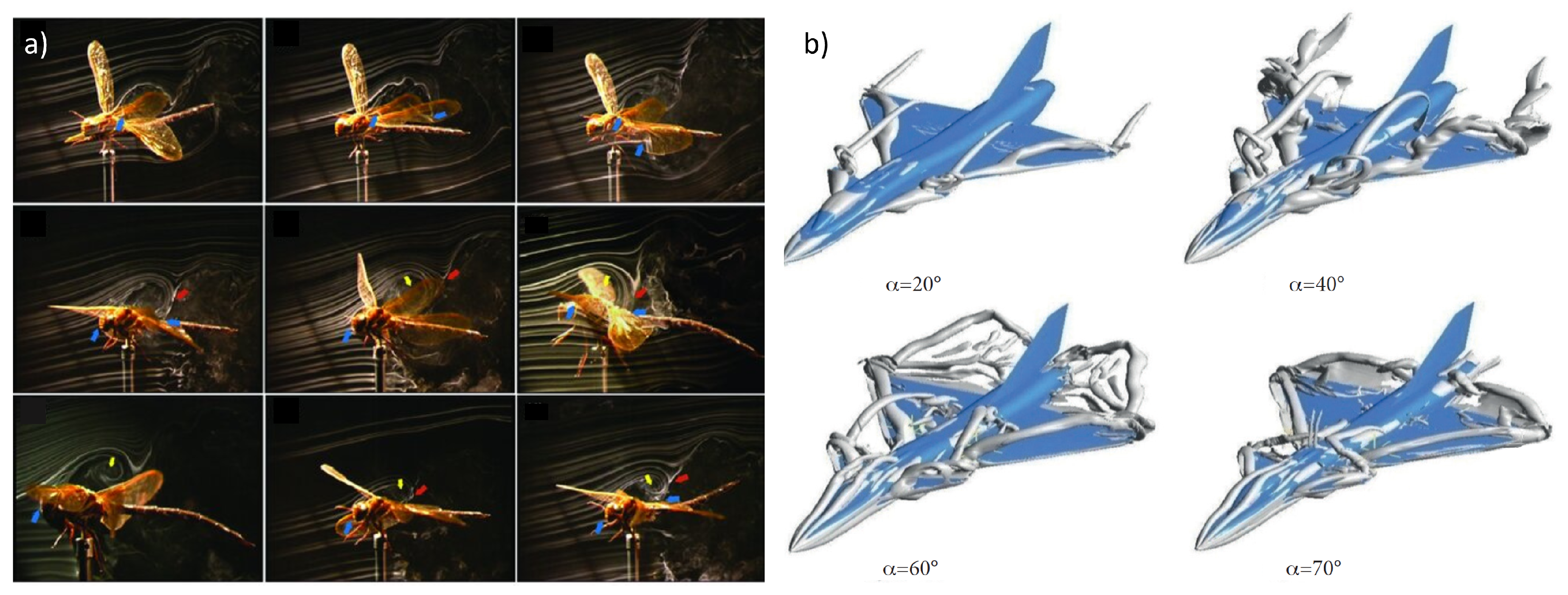

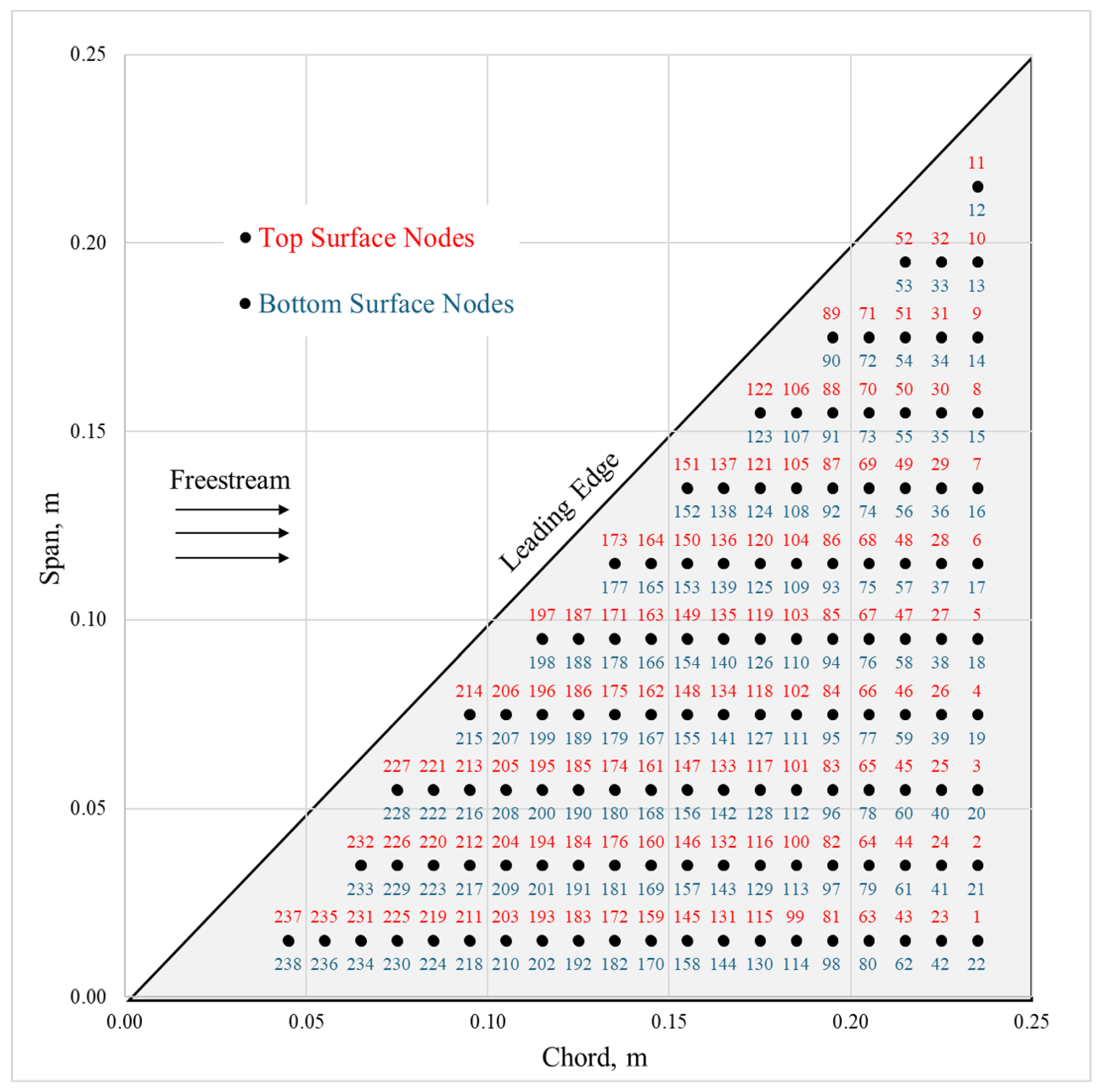


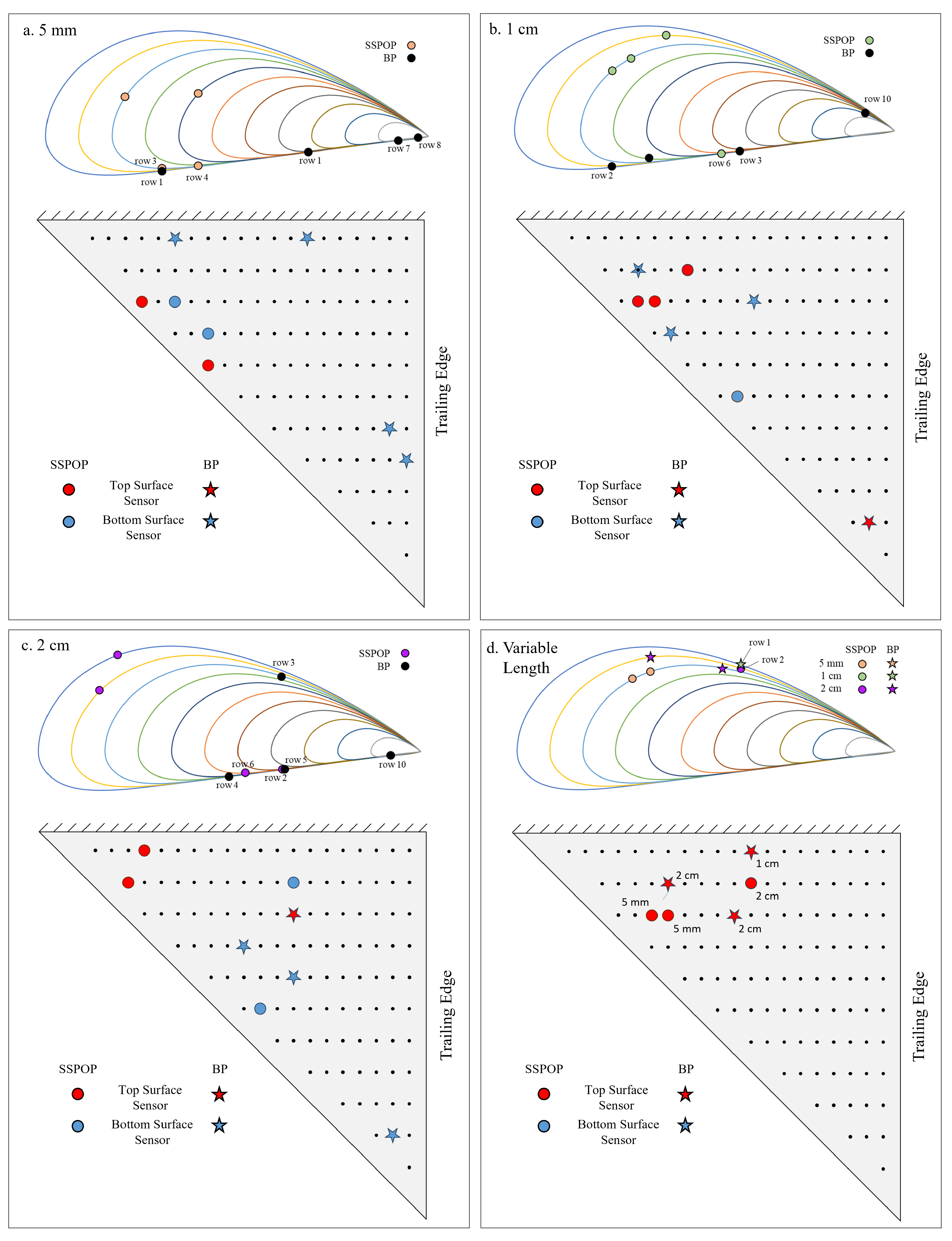
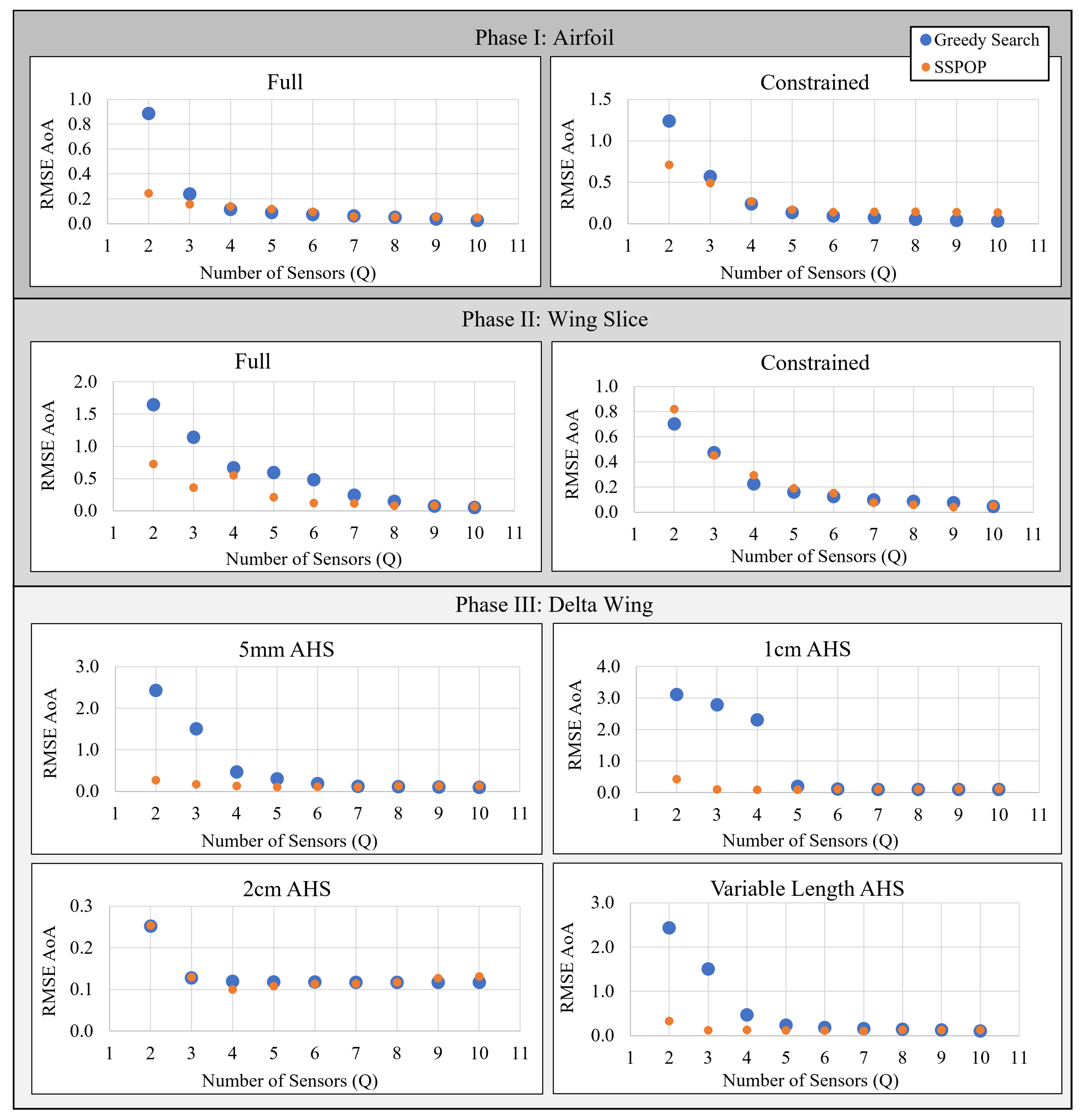
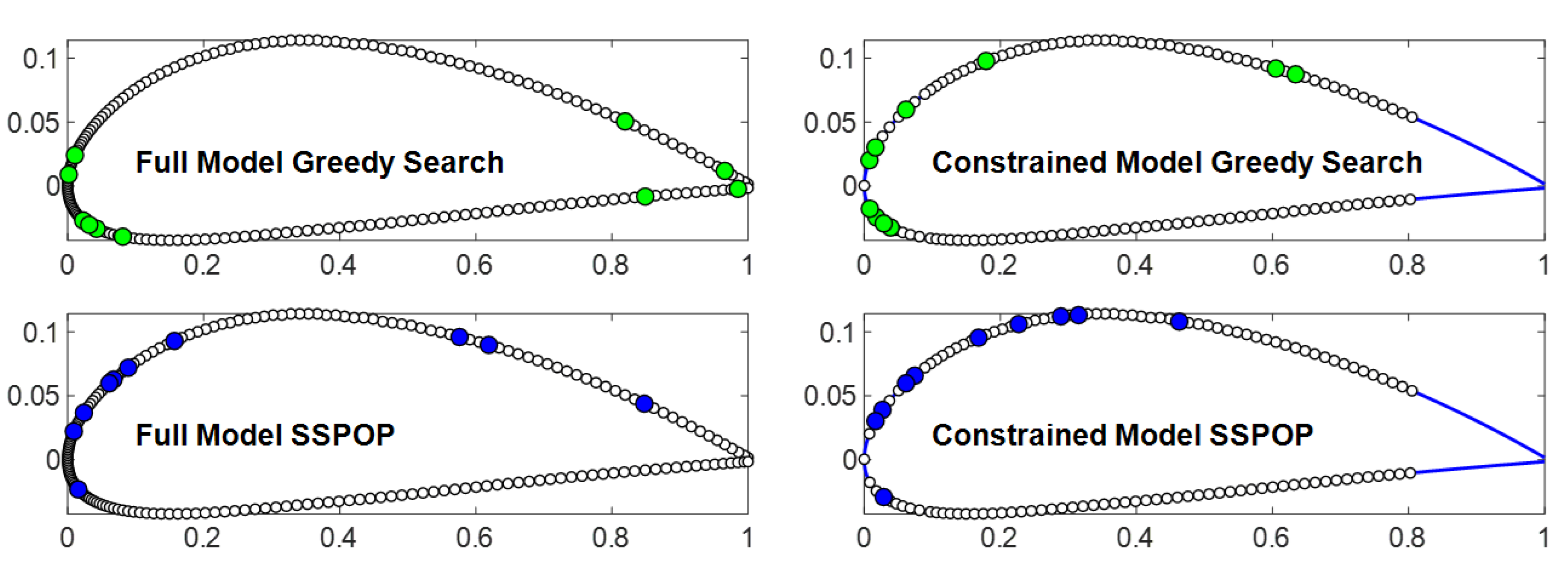

| SSPOP | SSPOP + Search | Best Possible | ||||||||||||||||
|---|---|---|---|---|---|---|---|---|---|---|---|---|---|---|---|---|---|---|
| Q | DP | RMSE (deg) |
Rank (%) |
DP | RMSE (deg) |
Rank (%) |
DP | RMSE (deg) |
||||||||||
| 5 cm | 1 | 227 | 7.517 | 2.521 | 13 | 7.105 | ||||||||||||
| 2 | 216 | 227 | 0.271 | 0.177 | 183 | 211 | 0.142 | 0.004 | 183 | 211 | 0.142 | |||||||
| 3 | 43 | 227 | 228 | 0.170 | 0.231 | 188 | 193 | 225 | 0.137 | 0.008 | 130 | 198 | 207 | 0.095 | ||||
| 4 | 197 | 199 | 216 | 227 | 0.131 | 0.105 | 130 | 142 | 158 | 232 | 0.125 | 0.055 | 15 | 36 | 130 | 218 | 0.045 | |
| 1 cm | 1 | 227 | 7.756 | 1.261 | 227 | 7.493 | ||||||||||||
| 2 | 215 | 227 | 0.426 | 3.865 | 21 | 224 | 0.125 | 0.004 | 210 | 224 | 0.125 | |||||||
| 3 | 153 | 213 | 232 | 0.106 | 0.048 | 156 | 161 | 223 | 0.060 | 0.000 | 145 | 167 | 208 | 0.043 | ||||
| 4 | 165 | 194 | 213 | 221 | 0.092 | 0.057 | 86 | 93 | 210 | 223 | 0.075 | 0.012 | 32 | 156 | 207 | 223 | 0.036 | |
| 2 cm | 1 | 227 | 8.009 | 0.420 | 227 | 8.009 | ||||||||||||
| 2 | 133 | 199 | 0.254 | 0.450 | 145 | 230 | 0.161 | 0.004 | 145 | 230 | 0.161 | |||||||
| 3 | 141 | 180 | 214 | 0.129 | 0.091 | 155 | 200 | 220 | 0.064 | 0.000 | 33 | 96 | 188 | 0.056 | ||||
| 4 | 143 | 165 | 225 | 232 | 0.100 | 0.111 | 112 | 157 | 189 | 218 | 0.088 | 0.042 | 33 | 133 | 140 | 178 | 0.038 | |
| Var. | 1 | 227 | 7.517 | 0.980 | 13 | 7.105 | ||||||||||||
| 2 | 64 | 215 | 0.331 | 1.288 | 156 | 223 | 0.080 | 0.000 | 156 | 223 | 0.080 | |||||||
| 3 | 146 | 205 | 213 | 0.121 | 0.061 | 206 | 210 | 234 | 0.097 | 0.012 | 145 | 161 | 204 | 0.039 | ||||
| Method | RMSE deg |
DP nodes | Method | RMSE deg |
DP nodes | |||||||||
| 5 mm | BF Search | 0.045 | 15 | 36 | 130 | 218 | 2 cm | BF Search | 0.038 | 33 | 133 | 140 | 178 | |
| BFGS (bot) | 0.099 | 22 | 109 | 168 | 210 | SSPOP | 0.100 | 143 | 165 | 225 | 232 | |||
| SSPOP | 0.131 | 197 | 199 | 216 | 227 | BFGS (top) | 0.143 | 1 | 7 | 23 | 226 | |||
| BFGS (top) | 0.145 | 1 | 9 | 137 | 235 | BFGS (bot) | 0.150 | 57 | 93 | 125 | 217 | |||
| 1 cm | BF Search | 0.036 | 32 | 156 | 207 | 223 | Var. | BF Search | 0.039 | 145 | 161 | 204 | ||
| SSPOP | 0.092 | 165 | 194 | 213 | 221 | SSPOP | 0.121 | 146 | 205 | 213 | ||||
| BFGS (bot) | 0.141 | 40 | 41 | 140 | 190 | BFGS (bot) | 0.123 | 19 | 98 | 207 | ||||
| BFGS (top) | 0.514 | 1 | 23 | 115 | 175 | BFGS (top) | 0.966 | 1 | 23 | 131 | ||||
Disclaimer/Publisher’s Note: The statements, opinions and data contained in all publications are solely those of the individual author(s) and contributor(s) and not of MDPI and/or the editor(s). MDPI and/or the editor(s) disclaim responsibility for any injury to people or property resulting from any ideas, methods, instructions or products referred to in the content. |
© 2024 by the authors. Licensee MDPI, Basel, Switzerland. This article is an open access article distributed under the terms and conditions of the Creative Commons Attribution (CC BY) license (http://creativecommons.org/licenses/by/4.0/).




